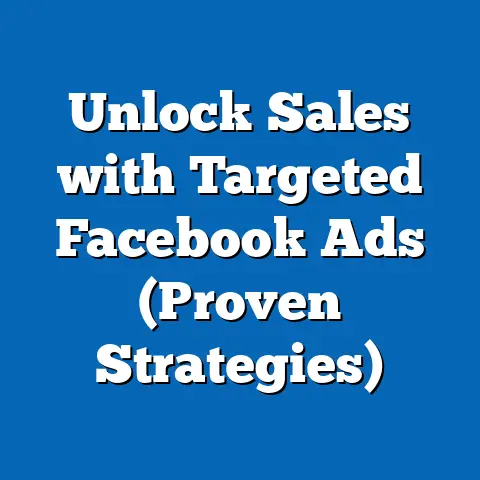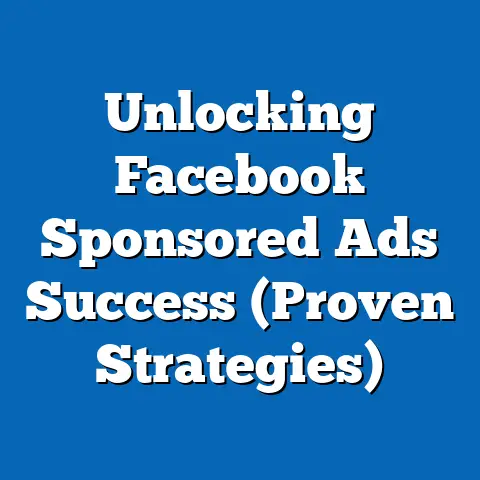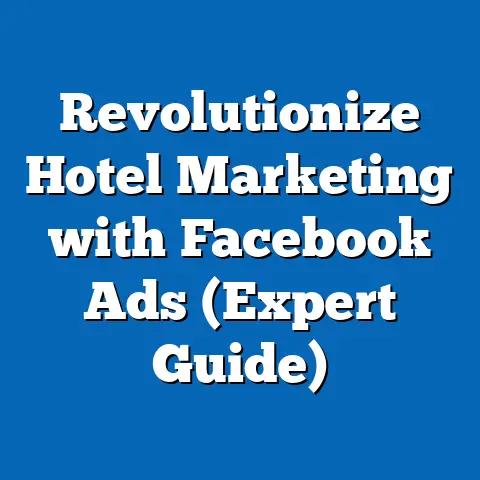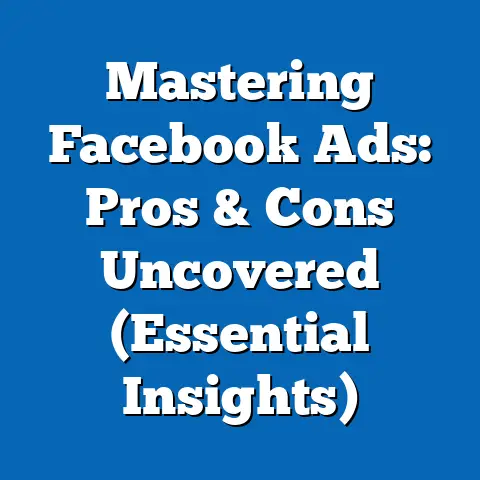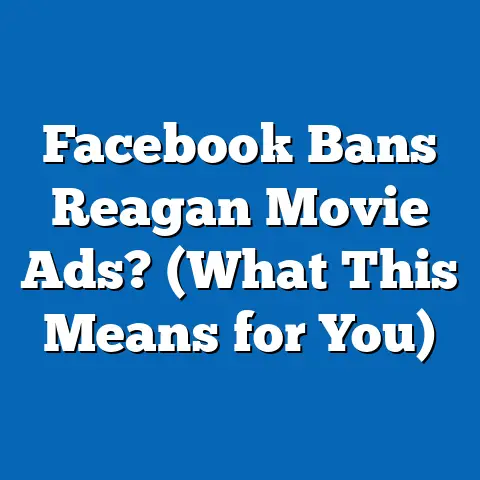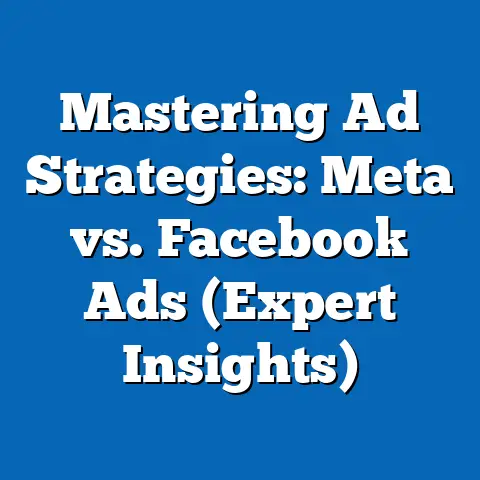Maximize Facebook Ad Vouchers (Unlock Hidden Profits)
I remember when I first started experimenting with Facebook Ads. It felt like throwing spaghetti at a wall and hoping something would stick. The costs seemed daunting, and the returns weren’t always immediate. Then, I discovered the power of Facebook Ad vouchers – and everything changed. These vouchers, often overlooked or underutilized, can be a game-changer, especially for small businesses and startups. In this guide, I’m going to share my experiences and insights on how to maximize these vouchers, turning them into tangible profits for your business.
Imagine you are the marketing director for a local bakery, “Sweet Delights,” which has recently started using Facebook Ads to promote its new line of artisanal pastries. You’ve been allocated a budget of $500 for Facebook advertising, and your goal is to maximize this budget by leveraging Facebook ad vouchers. However, you’ve heard whispers in the digital marketing community that many businesses are leaving money on the table by not fully utilizing these vouchers. Let’s dive into how you can unlock hidden profits by effectively maximizing Facebook Ad vouchers, ensuring that “Sweet Delights” reaches its target audience while boosting sales and brand awareness.
Understanding Facebook Ad Vouchers
What are Facebook Ad Vouchers?
Facebook Ad vouchers are essentially promotional credits that Facebook offers to advertisers. These credits can be used to offset the cost of running ads on the platform. Think of them as a coupon for your advertising budget. They are designed to encourage new advertisers to try the platform and to support existing advertisers in their marketing efforts.
How do Vouchers Work?
Vouchers typically come with specific terms and conditions:
- Eligibility: Vouchers are often targeted at new advertisers or those meeting specific criteria, like spending a certain amount in a previous period. Keep an eye on your email and Facebook Business Manager notifications for these opportunities.
- Redemption Process: Redeeming a voucher usually involves entering a code in your Facebook Ads Manager account. Make sure to do this promptly, as vouchers often have expiration dates.
- Types of Vouchers:
- Promotional Credits: These are typically offered to new advertisers to encourage them to start running ads.
- Seasonal Offers: Facebook occasionally offers vouchers during specific times of the year, such as holidays or special promotional periods.
- Partnership Deals: Sometimes, Facebook partners with other companies to offer ad vouchers as part of a bundled service or promotion.
- Promotional Credits: These are typically offered to new advertisers to encourage them to start running ads.
- Seasonal Offers: Facebook occasionally offers vouchers during specific times of the year, such as holidays or special promotional periods.
- Partnership Deals: Sometimes, Facebook partners with other companies to offer ad vouchers as part of a bundled service or promotion.
From my experience, the redemption process is straightforward. Once you receive a voucher code, navigate to the “Billing” section in your Ads Manager, and you should find an option to redeem it. Always double-check the terms, as some vouchers might require you to spend a certain amount before the credit is applied.
Why are Vouchers Significant for Small Businesses and Startups?
For small businesses and startups with limited marketing budgets, Facebook Ad vouchers can be a lifeline. They provide an opportunity to:
- Extend Reach: Vouchers allow you to reach a larger audience than you could with your original budget.
- Test Strategies: They provide a risk-free way to experiment with different ad formats, targeting options, and creative approaches.
- Boost ROI: By reducing the cost of advertising, vouchers can significantly improve your return on investment (ROI).
Takeaway: Facebook Ad vouchers are promotional credits that can significantly boost your advertising budget, especially for small businesses and startups. Keep an eye out for eligibility requirements and redemption processes to make the most of these opportunities.
Identifying Your Target Audience
Why is a Defined Target Audience Crucial?
Imagine trying to sell snow shovels in Hawaii – you’re not going to have much luck, right? Similarly, showing your bakery’s artisanal pastry ads to people who are strictly gluten-free and keto-followers is a waste of your precious ad budget. This is where the importance of a well-defined target audience comes in. The more precisely you define your audience, the more effective your ads will be.
Strategies for Identifying and Segmenting Your Audience
- Demographics: Start with basic demographic information like age, gender, location, education, and job title. For “Sweet Delights,” you might target people aged 25-55 within a 10-mile radius of the bakery.
- Interests: Identify the interests of your potential customers. Are they interested in baking, gourmet food, coffee, or local events? Facebook allows you to target users based on their expressed interests and hobbies.
- Behaviors: Consider the behaviors of your target audience. Are they frequent diners, online shoppers, or users of specific apps? Facebook tracks user behavior, allowing you to target people based on their online activities.
- Custom Audiences: Create custom audiences based on your existing customer data. You can upload a list of email addresses or phone numbers to Facebook, and the platform will match those contacts to Facebook users. This allows you to target your existing customers with specific ads.
- Lookalike Audiences: Once you have a custom audience, you can create a lookalike audience. Facebook will identify users who share similar characteristics and behaviors to your custom audience, allowing you to reach new potential customers who are likely to be interested in your products or services.
Leveraging Facebook’s Audience Insights
Facebook’s Audience Insights tool is a goldmine of information about your target audience. It provides detailed demographic data, interests, behaviors, and even lifestyle information about the people who like your page or are part of your custom audiences.
For example, if you upload your customer list to Facebook, you can use Audience Insights to discover what other pages they like, what types of content they engage with, and what their purchasing habits are. This information can then be used to refine your ad targeting and create more relevant ads.
Takeaway: Defining your target audience is paramount to maximizing the effectiveness of your Facebook ads. Use demographics, interests, behaviors, custom audiences, and Facebook’s Audience Insights to create highly targeted campaigns.
Crafting Compelling Ad Creative
Elements of Successful Ad Creative
The creative aspect of your ads is what will grab your audience’s attention and entice them to take action. Here are the key elements to focus on:
- Engaging Visuals: Use high-quality images or videos that showcase your products or services in an appealing way. For “Sweet Delights,” this might be a mouthwatering photo of a freshly baked croissant or a short video of a pastry chef decorating a cake.
- Persuasive Copy: Write ad copy that speaks directly to your target audience and highlights the benefits of your product or service. Use compelling language and address their pain points or desires. For example, “Indulge in our new line of artisanal pastries – the perfect treat for your morning coffee or afternoon delight!”
- Clear Calls-to-Action (CTAs): Tell people exactly what you want them to do. Use strong, action-oriented CTAs like “Shop Now,” “Learn More,” “Visit Our Bakery,” or “Order Online.”
Tailoring Ad Creative to Your Audience
It’s not enough to create a single ad and hope it resonates with everyone. You need to tailor your ad creative to each specific audience segment.
For example, if you are targeting young professionals, you might use a more modern and trendy visual style with ad copy that emphasizes convenience and indulgence. If you are targeting older adults, you might use a more classic and elegant visual style with ad copy that emphasizes quality and tradition.
A/B Testing Your Creatives
A/B testing, also known as split testing, involves creating multiple versions of your ad creative and testing them against each other to see which performs best. This is a crucial step in maximizing the effectiveness of your ad vouchers.
For example, you might test two different headlines, two different images, or two different CTAs. Run both ads simultaneously and track their performance. After a few days or weeks, you can analyze the results and determine which version performed better. Then, you can focus your budget on the winning ad and continue to test new variations.
Takeaway: Compelling ad creative is essential for capturing your audience’s attention and driving results. Use engaging visuals, persuasive copy, and clear CTAs. Tailor your creative to each audience segment and use A/B testing to optimize your ads for maximum performance.
Strategic Budget Allocation
Effective Budget Allocation
Allocating your budget strategically is crucial for maximizing your ROI. You need to determine how much to spend on each ad campaign and how to distribute your budget over time.
- Campaign Objectives: Start by defining your campaign objectives. Are you trying to increase brand awareness, drive website traffic, generate leads, or make sales? Your objectives will influence how you allocate your budget.
- Target Audience: Consider the size and potential value of your target audience. If you are targeting a large audience with high potential value, you may want to allocate a larger budget.
- Ad Placement: Decide where you want your ads to appear. Facebook offers a variety of ad placements, including the news feed, right column, Instagram, and Audience Network. Different placements have different costs and performance characteristics.
- Bidding Strategy: Choose a bidding strategy that aligns with your campaign objectives. Facebook offers several bidding options, including cost per click (CPC), cost per impression (CPM), and optimized cost per mille (oCPM).
Understanding CPC and CPM
- Cost Per Click (CPC): This is the amount you pay each time someone clicks on your ad. CPC is a good option if you are trying to drive website traffic or generate leads.
- Cost Per Impression (CPM): This is the amount you pay for every 1,000 impressions your ad receives. CPM is a good option if you are trying to increase brand awareness.
To illustrate, let’s say “Sweet Delights” wants to drive traffic to its online ordering page. If the average CPC for their target audience is $0.50, a $50 ad voucher could potentially generate 100 clicks. On the other hand, if they aim for brand awareness and the CPM is $5, the same voucher could deliver 10,000 impressions.
Budget Pacing
Budget pacing refers to how you distribute your budget over time. You can choose to spend your budget evenly throughout the day or week, or you can concentrate your spending during peak hours or days.
- Daily Budget: Set a daily budget that reflects how much you are willing to spend each day.
- Lifetime Budget: Set a lifetime budget for your entire campaign. This allows you to control your total spending and ensure that you don’t exceed your budget.
- Ad Scheduling: Use ad scheduling to show your ads only during the times when your target audience is most likely to be online and engaged.
Takeaway: Strategic budget allocation is critical for maximizing your ROI. Define your campaign objectives, understand your target audience, choose the right ad placements, and use budget pacing to optimize your spending over time.
Leveraging Facebook’s Ad Tools
Key Facebook Ad Tools and Features
Facebook offers a suite of powerful tools and features that can help you maximize the effectiveness of your ad vouchers.
- Facebook Pixel: The Facebook Pixel is a snippet of code that you install on your website. It allows you to track conversions, retarget website visitors, and optimize your ads for specific actions.
- Audience Insights: As mentioned earlier, Audience Insights provides detailed demographic data, interests, behaviors, and lifestyle information about your target audience.
- Ad Manager: The Ad Manager is your central hub for creating, managing, and tracking your Facebook ad campaigns. It provides a variety of tools and features for targeting, bidding, creative development, and reporting.
Tracking Conversions and Measuring Success
Tracking conversions is essential for measuring the success of your Facebook ad campaigns. By tracking conversions, you can see which ads are driving the most valuable actions, such as website visits, leads, or sales.
To track conversions, you need to install the Facebook Pixel on your website and set up conversion events. A conversion event is a specific action that you want to track, such as a purchase, a lead form submission, or a page view.
Retargeting and Lookalike Audiences
- Retargeting: Retargeting involves showing ads to people who have previously visited your website or interacted with your brand on Facebook. This is a highly effective strategy because these people have already expressed an interest in your products or services.
- Lookalike Audiences: As mentioned earlier, lookalike audiences allow you to reach new potential customers who share similar characteristics and behaviors to your existing customers. This is a great way to expand your reach and find new customers who are likely to be interested in your products or services.
Takeaway: Facebook offers a powerful suite of tools and features that can help you maximize the effectiveness of your ad vouchers. Use the Facebook Pixel to track conversions, Audience Insights to understand your target audience, and the Ad Manager to create, manage, and track your campaigns.
Analyzing and Optimizing Campaign Performance
Continuous Monitoring and Analysis
Running Facebook ads isn’t a “set it and forget it” kind of deal. You need to continuously monitor and analyze your campaign performance to identify areas for improvement.
- Regular Check-Ins: Set aside time each day or week to review your ad performance.
- Key Performance Indicators (KPIs): Track the KPIs that are most relevant to your campaign objectives. These might include click-through rate (CTR), conversion rate, cost per conversion, and return on ad spend (ROAS).
- Performance Trends: Look for trends in your data. Are certain ads performing better than others? Are certain targeting options more effective? Are there specific times of day or days of the week when your ads are more likely to convert?
Key Performance Indicators (KPIs) to Track
- Click-Through Rate (CTR): This is the percentage of people who see your ad and click on it. A high CTR indicates that your ad is relevant and engaging to your target audience.
- Conversion Rate: This is the percentage of people who click on your ad and then take a desired action, such as making a purchase or filling out a form. A high conversion rate indicates that your landing page is effective and that your offer is compelling.
- Cost Per Conversion: This is the amount you pay for each conversion. A low cost per conversion indicates that your ad campaign is efficient and cost-effective.
- Return on Ad Spend (ROAS): This is the amount of revenue you generate for every dollar you spend on advertising. A high ROAS indicates that your ad campaign is profitable.
Actionable Strategies for Optimization
- Refine Targeting: If your ads aren’t performing well, try refining your targeting options. Experiment with different demographics, interests, and behaviors to see what works best.
- Improve Ad Creative: If your CTR is low, try improving your ad creative. Use more engaging visuals, write more persuasive copy, and test different CTAs.
- Optimize Landing Page: If your conversion rate is low, optimize your landing page. Make sure it is relevant to your ad, easy to navigate, and optimized for conversions.
- Adjust Bidding Strategy: If your cost per conversion is high, adjust your bidding strategy. Try lowering your bids or switching to a different bidding option.
Takeaway: Continuous monitoring and analysis are essential for optimizing your Facebook ad campaigns. Track your KPIs, look for performance trends, and implement actionable strategies to improve your results.
Case Studies and Real-World Examples
Case Study 1: Local Restaurant
A local restaurant used a Facebook Ad voucher to promote its new lunch menu. By targeting people within a 5-mile radius of the restaurant who were interested in dining out and lunch specials, they were able to increase lunchtime traffic by 20%. The restaurant also used retargeting to show ads to people who had previously visited its website or interacted with its Facebook page.
Case Study 2: E-Commerce Store
An e-commerce store used a Facebook Ad voucher to promote its summer sale. By targeting people who had previously purchased from the store or added items to their cart but didn’t complete the purchase, they were able to increase sales by 15%. The store also used lookalike audiences to reach new potential customers who shared similar characteristics and behaviors to their existing customers.
Case Study 3: Startup Tech Company
A startup tech company leveraged Facebook Ad vouchers to promote their new mobile app. By targeting tech enthusiasts and early adopters, they significantly increased app downloads. They also used a compelling video ad showcasing the app’s features and benefits, which resonated well with their audience.
Takeaway: Real-world examples demonstrate the potential of Facebook Ad vouchers to drive tangible results. By implementing the strategies discussed in this guide, you can unlock hidden profits and achieve your marketing goals.
Conclusion: The Road to Unlocking Hidden Profits
Facebook Ad vouchers are an invaluable tool for businesses looking to amplify their marketing efforts, especially when budgets are tight. As I’ve shown, their effectiveness hinges on a strategic approach that includes understanding your target audience, crafting compelling ad creatives, allocating your budget wisely, leveraging Facebook’s ad tools, and continuously analyzing and optimizing your campaign performance.
For “Sweet Delights,” this means using demographic and interest-based targeting to reach local pastry enthusiasts, crafting mouthwatering visuals of their artisanal creations, and using Facebook Pixel to track online orders. By continuously monitoring KPIs like CTR and conversion rates, they can fine-tune their campaigns for maximum ROI.
I encourage you to take action today and implement the strategies discussed in this guide. Start by identifying your target audience, crafting compelling ad creative, and allocating your budget strategically. Use Facebook’s ad tools to track your progress and optimize your campaigns. And don’t forget to share your successes in the comments or on social media!
Call to Action: Subscribe to our newsletter for more insights on digital marketing strategies. Follow our business page for updates on new Facebook ad techniques and promotions, including future voucher opportunities. Let’s turn those vouchers into profits!

